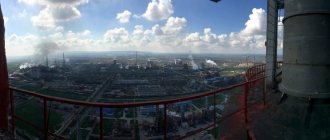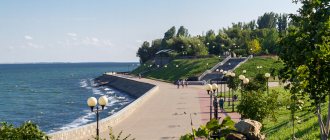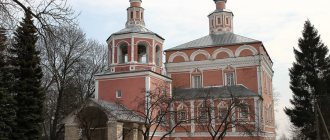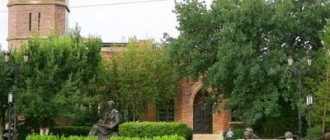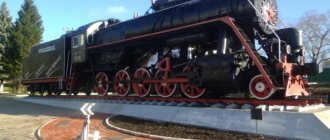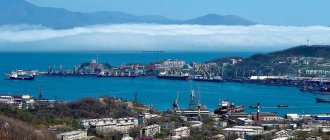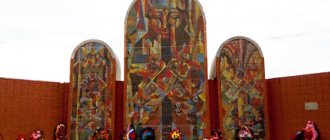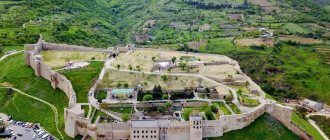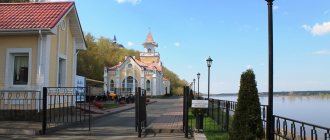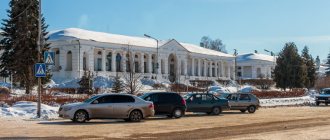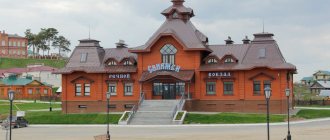Before returning to publications on the main topic of the blog, I decided to finally complete a mini-cycle of notes about Rossoshi, a regional center in the Voronezh region, where we spent several days in August of this year. What has already happened: photos of the city of Rossosh, general impressions and a story about the Rossosh monuments. Now I would like to dwell on what other interesting places there are in this town that you can see here in one or two days.
Oddly enough, even in one day you can see most of the interesting places and objects, and if you travel by transport, then all the sights of Rossosh. The photos that have already been published earlier and those that will be on this page were taken during our two walks around the city with a total duration of about six hours. It is not surprising that most of the photos from walks are cloudy, because... in sunny weather we spent time near the Black Kalitva - a local river, much cleaner than the Voronezh Don and Usmanka, beach holidays on which are becoming more and more dangerous to health every year.
We didn’t visit only two places: Yubileiny Park and Rossosh railway station. These attractions deserve separate notes, which may someday appear here.
Temple of St. Alexander Nevsky
Initially, the church was conceived as a bell tower at the Church of the Exaltation of the Holy Cross. This temple was badly damaged during the Second World War, and was subsequently built into a press plant. So, there is little left of him. The Church-bell tower of St. Alexander Nevsky itself was founded in 1861, and 15 years later, in 1876, construction was completed.
The church was built according to the design of the prominent Moscow architect Pyotr Petrovich Burenin, known for his search and development of the original Russian style in architecture. It should be noted that the construction took place with the support of the landowner Alexander Dmitrievich Chertkov. The temple on the first floor of the bell tower was named in his honor.
Location: Oktyabrskaya Square.
... and a few words about cartography
When searching for exact addresses for Rossoshi attractions, I came across a curious fact: online maps for the regional center with a population of more than 60 thousand people are still far from perfect. As an example, I will show how Yandex and Google see the same object (the Emerald children's complex).
On Google Maps, the address of the object is at least geographically assigned to the street on which it is located. However, the object itself is not on the map.
Yandex maps see the building, but show a different street. In addition to the misunderstanding with the address, there is one more point: the beloved Yandex and the snippet for the object display an annoying spelling error.
And this is not an isolated case. I came to the conclusion that there is no point in trusting online maps unconditionally for now.
Accordingly, information read from them should be disseminated with great caution.
Museum of Local Lore
At the moment, the museum is located in the building of the “Smile” kindergarten, built according to an Italian design. On the site where the headquarters of the Italian Alpine Riflemen was located during World War II. The museum collection contains many exhibits. There is a hall dedicated to the history of the city and settlement of Rossosh.
A hall with a very rich exposition dedicated to the Second World War, because the Ostrogozh-Rossoshan operation took place in the city area on January 13-27, 1943, and in the same hall there is an exposition dedicated to the restoration of good relations with Italy. There are also several halls with a collection of works by local Rossoshinsky artists.
Location: Oktyabrskaya Square - 20A.
Instead of poplars - spruce
The difference between these photographs is almost 70 years. In the 1960s, a school was located in the building of the current military registration and enlistment office.
“Externally, the building has hardly changed, except for the windows,” notes the photographer. “But in front of the building there were young trees, most likely poplars. They are not present in the modern photo, but there are fluffy spruce trees.
There was also no wide asphalt roadway. The narrow road is barely visible in the old photo.
– I remember studying at this school, then it was No. 5. In the mid-1970s, the current Lyceum No. 4 was built, and we were transferred to the building where the Quantorium children's technology park is now located. Afterwards, the school became a military registration and enlistment office,” Rossoshan resident Vasily Bondarev shared his memories.
Train Station
The railway station building is an architectural monument of the 19th century; the station was opened in 1871. On the outer wall of the building on the city side there is a memorial plaque stating that during the Civil War, a voluntary communist detachment was formed from railroad workers, which took an active part in liberating the city from the whites.
It must be said that during the Second World War, the station building played a noticeable role, since supplies for Italian and German troops went through the station. The battle for the Rossoshi railway station broke out in January 1943; during the Ostrogozh-Rossoshan offensive operation, Soviet troops managed to liberate the station and the city itself. In memory of this event, a monument was erected at the station.
Location: street.
About the history of the city
Before becoming a city, Rossosh remained a settlement for centuries.
Even when, according to the 1916 census, more than 9.5 thousand people already lived in Rossosh. The population of the city of Ostrogozhsk in the same year did not reach 7 thousand, and another neighboring county town, Boguchar, was less than 4 thousand people. The year the settlement was founded is unknown. It was first mentioned in a church document from 1721. From it we can conclude that the Rossosh settlement was a fairly large settlement and had existed for several decades. It was a settlement of Cherkasy (i.e. Zaporizhian Cossacks): thatched Ukrainian mud huts and the wooden Church of the Exaltation of the Cross. Local rivers were then much wider and deeper and, in combination with the vast swamps that have now disappeared, they represented an excellent natural defense against the predatory raids of nomads.
Later, when Rossosh ceased to be the outskirts of the empire, but found itself inside it, a large road from Central Russia to the region of the Don Army ran through the settlement. There was no industry in the settlement, with the exception of small handicraft brick production, distilleries, mills and forges. But trade was very lively: Rossoshan fairs were distinguished by solid turnover. It became even more powerful when, in 1871, railway traffic began here to Rostov-on-Don.
The coat of arms and flag of the city of Rossoshi look like this.
The Soviet government awarded Rossoshi the status of a city in 1923. Interestingly, in 1929, an attempt was made to Ukrainize the region. Since 86% of its population remained descendants of Cherkasy, it was decided to introduce the Ukrainian language in office work, schooling, the local newspaper, etc. However, these initiatives did not take root, and their remnants were completely canceled by 1933.
In 1937, a stronghold for horticulture of the Michurin Research Institute was opened near the city. Subsequently, it was transformed into a fruit and berry experimental station. Dozens of new varieties of apple trees, apricots and other garden crops were developed here.
During the Great Patriotic War, Rossosh spent six months under the occupation of German and Italian troops. A huge group of fascist troops was supplied through this large railway junction. It was of enormous strategic importance, and Soviet troops, doing everything possible and impossible, drove the enemies out of Rossosh in January 1943.
Peacetime was marked by the “All-Union Shock Komsomol Construction” in Rossosh: the construction of a mineral fertilizer plant (1974-1979). OJSC Minudobreniya is one of the leaders in this industry in our time.
Temple of Elijah the Prophet
The first stone of the temple was laid on September 19, 2000. Due to the difficult financial situation, construction took a long time. The temple was completed only in 2006; the ceremony of the great illumination of the temple took place on August 1. The building was built in the traditional spirit of Russian architecture, according to the design of two architects P. V. Dudin and V. M. Zakharov.
This is not the first Temple of the Prophet Elijah in Rossosh. The temple with this name was founded at the end of the 19th century, however, during the years of Soviet power, like many other church buildings, it was dismantled into bricks. Not a single image of this temple remains; it is only known that it was built in the New Byzantine style.
Location: Oktyabrskaya Square - 19.
Lysva
Lysva was known as a settlement already in the middle of the 17th century. In the second half of the 18th century, the lands around Lysva were inherited by the daughter of Baron A. G. Stroganov, Princess V. A. Shakhovskaya. In 1785, the construction of an iron foundry began, permission for the construction of which was received by Shakhovskaya in the Perm Treasury Chamber. This year is officially considered the year of Lysva’s founding. The blast furnace produced its first smelting on December 2, 1787. As the plant developed, the village also developed, becoming in the 19th century. the center of the Lysvensky factory district. In 1902, thanks to the construction of a railway line connecting Lysva with the Kalino station of the Gornozavodskaya Railway, the plant, which by that time was producing iron from imported cast iron, received wide access to the country's markets.
Lysva strike and uprising at the plant (1914)
Main article: Lysva uprising
At the beginning of the 20th century, the number of workers at the Lysvensky plant increased sharply. In 1905, the plant employed 2,340 people, in 1914 - more than 6,000.
In 1914, an uprising broke out at the Lysvensky plant. Historians have different assessments of it. Soviet historians regarded it as a statement against mobilization for the First World War. In the 1990s–2000s, historians took a more cautious position. O. S. Porshneva, as well as S. P. Postnikov and M. A. Feldman, regarded this speech as a struggle of workers against the factory administration. Ekaterinburg historians A.V. Dmitriev and N.G. Pavlovsky conducted a study of the documents of the uprising and reconstructed the course of events in detail, publishing some documents on it.
The uprising was preceded by a strike at the plant, which lasted from March 15 to May 29, 1914. The strikers demanded: to increase daily wages by 25%, to establish an eight-hour working day, to pay double overtime, to cancel fines, to pay for strike days, to improve sanitary and hygienic working conditions, to provide workers with free pasture for livestock, preferential conditions for the use of hayfields and supplies firewood. The housing issue also played a role, since one of the demands was to provide either apartments or “apartment money” (5 rubles for singles, 10 for families). The administration agreed to partially satisfy the demands, but the strike continued. Fuel was added to the fire by the news received in April 1914 that the owner had decided to give bonus money to factory employees, as well as make a charitable donation in the amount of 350 thousand rubles. On May 29, 1914, strikers began to go to work.
On July 18, 1914, mobilization was announced and the factory workers began to receive pay. 714 people were drafted from the entire district. The mobilized also demanded that they be paid an additional two weeks' salary, which was fulfilled by the plant manager K. M. Dobrovolsky. The requirement was also fulfilled to provide those being mobilized with the same allowance as in 1904 during the Russo-Japanese War. The workers demanded that they be given 350 thousand rubles, donated for charitable purposes by the heirs of P. P. Shuvalov. Riots began, during which 10 police officers and employees were killed, including the manager of the Lysva district, A. I. Onufrovich. Perm Governor I.F. Koshko sent a detachment of 32 guards, arrests were made.
Soviet period
On April 5, 1926, by a resolution of the Presidium of the All-Russian Central Executive Committee, Lysva was given the status of a city. After the end of the Great Patriotic War, the development of mechanical engineering and light industry began in Lysva. In 1952, the Lysvensky Turbogenerator Plant began production. In the 1950s The city center is being built up. In the 1960s–1980s, the city expanded its borders through the construction of new residential neighborhoods. In the 1970s and 1980s, private houses on the shore of Travyansky Pond were demolished and a children's park was laid out in their place. In 1987, the city was awarded the Order of the Badge of Honor.
Our days
Today Lysva is one of the most important industrial and cultural centers of the Kama region (5th place in terms of industrial output).
City Park "Yubileiny"
Yubileinye Park can be called the calling card of the city. Many city events take place on its territory: concerts, bicycle parades, exhibitions and other public events. This is a small green area in the city center, a good place for walking with children. On the territory of the park there is a pond, several attractions, including a Ferris wheel.
Location: Lenin Square - 4.
Cafe-bar "Raketa"
The establishment is located inside a decommissioned hydrofoil river boat, to the right of the bridge connecting the old part of the city with the new one. It has been standing here, according to townspeople, for decades. At the same time, there are big doubts that the Sukhaya Rossosh River, on the banks of which the Raketa cafe is located, was ever navigable.
We didn’t go down to the “Rocket” because... the establishment was also closed. It is possible that now it is not functioning at all: the area around is overgrown with reeds, access to the facility is not the most convenient, and there is no parking nearby.
View of the river from the road bridge, a hundred meters from which the “Rocket” is located.
Youth
The Youth Center building was built in 2012. This is a multi-story building in the center of the city, surrounded by an old pine park. Here under one roof there are: a concert hall designed for 400 people ; two cinema halls equipped with modern equipment; an observatory where anyone can watch the stars. This is one of the most beautiful places in the city and the pride of Rossosh. Also attracting attention is the public transport stop in front of the youth center, which is a huge umbrella.
Holiday demonstration
The following photo was taken in 1933. People with banners walk along the building of the district party committee.
– Now there is a dental clinic there. In those years, modern Proletarskaya Street was narrow, and the road was located to the right of the modern roadway. From the district committee people turned towards the hospital. Now they would be walking along Student Square. It is also interesting to look at the clothes of our ancestors. People were in jackets, all the men were wearing hats, mostly caps. Women - in scarves or hats. There were no cars, instead there were horses and carts, and the musicians played instruments: in the foreground is a drummer. It was interesting to plunge into this atmosphere for a while,” said Dmitry Reznikov.
Monument to Marshal P. S. Rybalko
The opening ceremony of the monument took place on January 13, 2013, on Tanker Square. The sculptor Nikolai Fedorovich Sheptukhin was also present at the ceremony. The sculpture of Pavel Semenovich Rybalko, cast in full-length bronze, stands on a pedestal. During the Great Patriotic War, P. S. Rybalko commanded the third tank division, through whose efforts Rossosh was liberated from occupation forces in 1943.
Marshal P.S. Rybalko is twice Hero of the Soviet Union, but ordinary tankers are also remembered in the city. Here on the square there is a monument to the tank crews - the liberators of the Rossoshanskaya land. The monument is an IS-3 tank mounted on a pedestal.
Education
In 1931, a poultry technical school was created, in 1950 it was transformed into a meat and dairy technical school, now called the Rossoshansky College of Meat and Dairy Industry.
Currently, the following institutions of secondary vocational education operate in the city:
- "Rossoshan College of Meat and Dairy Industry";
- "Rossoshansky College of Agricultural and Construction Transport" (former vocational school No. 29);
- "Rossoshansky Construction College" (former vocational lyceum No. 56);
- "Rossoshansky Chemical-Mechanical College" (former professional lyceum No. 55);
- "Rossoshansky Medical College";
- Rossoshansky Pedagogical College.
Stele “Settlement of Military Valor”
This is one of five steles installed in the Voronezh region in memory of the Rossoshansk-Ostrogozh offensive operation and Operation Little Saturn. The remaining four steles stand in Ostrogozhsk, Korotoyak, Verkhny Mamon and Kantemirovka. They were installed specifically for the 70th anniversary of Victory in the Great Patriotic War. The grand opening took place on May 6, 2013, with veterans and home front workers present as guests of honor.
Palace of Celebrations
It is also the Wedding Palace. It's also a Youth Center. Address: st. Proletarskaya, 110B. Inside there is a fairly spacious hall with two floors. There is a cinema and concert hall, the poster of which includes not only the latest cinema, but also performances of pop stars coming to the city.
A very interesting architectural object that clearly decorates the appearance of the city. The area around the center looks landscaped and well-groomed. Both native townspeople and those who visited Rossosh for the first time come here to take selfies for social networks. Attractions, photos and descriptions of which inevitably end up in Russian-scale tourist aggregators, I am sure, will be supplemented by this place in the near future.
An original sculptural group in the fountain opposite the main entrance. A wonderful place for wedding photography.
A carriage drawn by two pairs of openwork metal horses is to the left of the Palace of Celebrations. Apparently, this is also one of the places for photographing newlyweds. True, it’s not very successful; against almost any background, translucent horses simply get lost.
But what function the two-meter green horse to the right of the building performs is not entirely clear. But the fact that it has been installed here for a long time can be seen from the steel support plates sticking out of the ground, to which the animal’s frame is welded.
A quick search for the phrase “green horse” showed that there is a children’s fairy tale by the Soviet writer Yuri Koval with that name. I’ll have to get acquainted with his works, my daughter is now at that very age when fairy tales are perceived with special awe and emotionality)
The bus stop near the Rossoshansky Palace of Celebrations is made in the form of an umbrella, under which you can wait out the light rain while waiting for the minibus.
